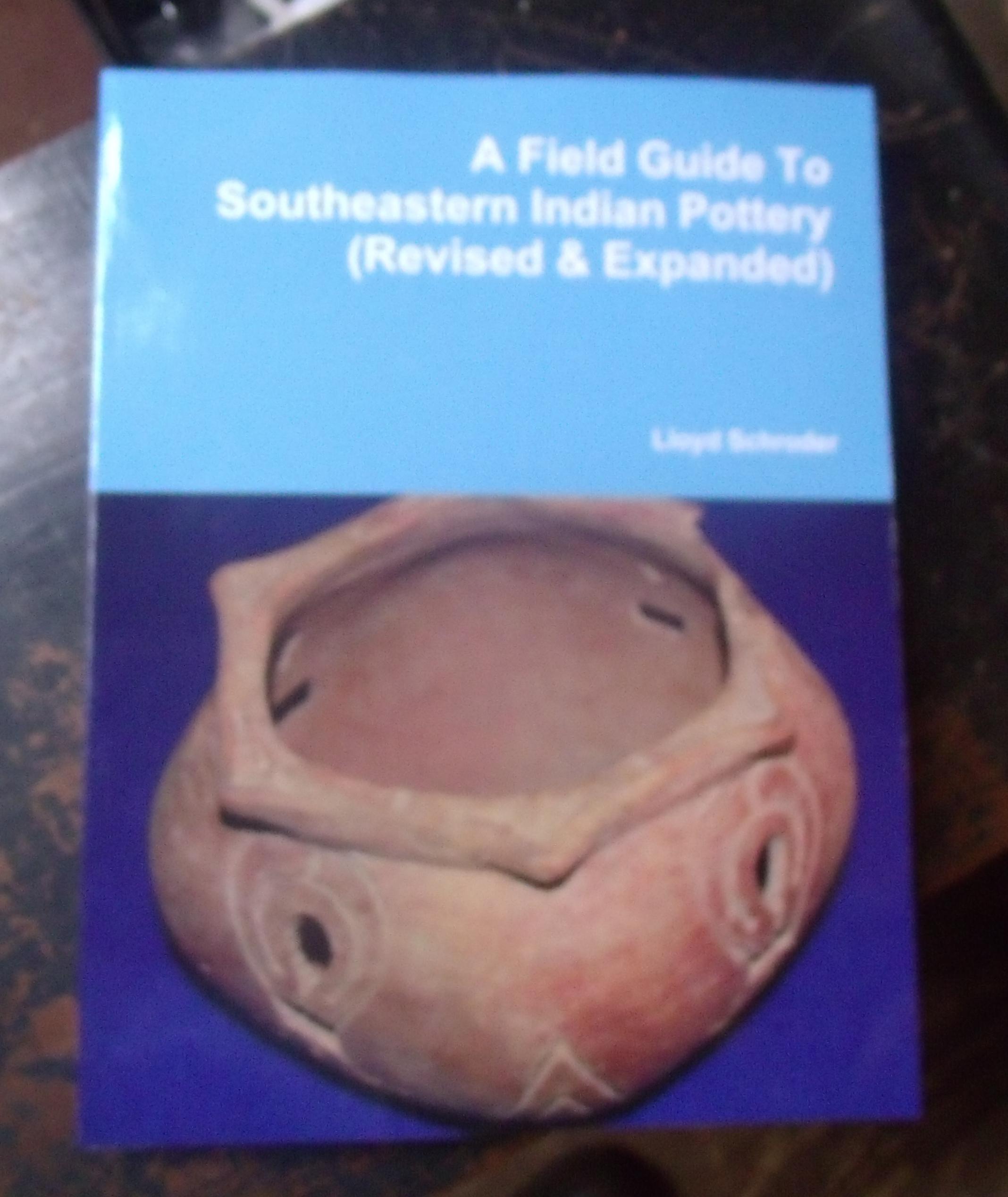It is our hope that the pictures and descriptions in this section will assist you in discovering the identity of your pottery sherds and the history behind them. If you are unable to identify your finds from this list, please feel free to contact me (Lloyd Schroder – see CONTACT US) with pictures of your discoveries and information regarding their general location. The pictures should include a clear picture of surface decoration, rim structure (if possible), the interior of the vessel, and a cross-section of the sherd. I will make every effort to respond as quickly as possible to your requests.
For more detailed information on these and other pottery types within the Southeastern United States, please see our “Publications” page to order Lloyd Schroder’s Field Guide to Southeastern Indian Pottery (Revised & Expanded).
This amazing new book contains over 500 pottery types, each explained in very readable terms with thousands of illustrations and maps of distribution. The volume has earned the acilades of senior archaeologists like David Anderson of the University of Tennessee and well-known Georgia archaeologist Jerald Ledbetter. No serious student of archaeology should be without it.

RESEARCH: Caryn Y. Hollingsworth discussed this type in 1991.[i] Hollingsworth did his research at the Sheep’s Bluff Shelter site in Franklin Co, Alabama.
TEMPER: This type was the only grog-tempered ware encountered by Hollingsworth that did not belong to the McKelvey series.
SURFACE DECORATION: The exterior surface of the vessel was covered with a dark, rusty red film.
VESSEL FORMS: Unknown
CHRONOLOGY: This type first appeared during the Middle Woodland period, but may have lasted into the Early Mississippian period between A.D. 500 and A.D. 1000.
GEOGRAPHIC DISTRIBUTION: This type occurs frequently within the upper Tombigbee River watershed, but is most plentiful in the lower Mississippi Valley.
[i] Hollingsworth, Caryn Y. Ceramic Descriptions and Discussion, Journal of Alabama Archaeology Vol 37, p.101
RESEARCH: Gordon Willey defined this type in 1949 from his work in sites along the Northwest Gulf Coast of Florida.[i]
TEMPER: This type was tempered with crushed shell that also contained small amounts of sand and grit. The paste core is gray with a buff exterior.
SURFACE DECORATION: The surface may have originally been polished and had a medium to dark red slip applied to the surface. This is a rare type, but is found and identified when found with other Pensacola pottery with the same paste.
VESSEL FORMS: Vessel forms conform to the Fort Walton forms including shallow bowls, casuela bowls, collared globular bowls, short-collared jars, beaker-bowls, bottles and flattened globular bowls with affixed effigies. Rims are usually unmodified. “Cookie-cutter” effigies are frequently affixed to the rims with an opposite appendage on the opposing side.
CHRONOLOGY: This is an Early to Middle Woodland, Fort Walton period pottery type.
GEOGRAPHIC DISTRIBUTION: This type has its focus in western Florida, but extends from the Mobile Bay of Alabama northward to at least the Fall Line of central Alabama.
[i] Willey, Gordon R., Archaeology of the Florida Gulf Coast, Bureau of American Ethnology Smithsonian Institution, 1949, p.446
Temper: tampered with fine sand and micah. Buff-fired surfaces. Both interior and exterior surfaces are smooth, occasionally polished.
Distribution: from Franklin to Citrus counties along the Gulf Coast of Florida.
Age: middle Woodland, Santa Rosa-Swift Creek period
Vessel Forms: eccentric you-shaped double vessel and cylindrical beaker
Decoration: combination of line incision and enclosed red zones. Lines have been made when paste has been extremely dry but before firing. Lines are medium broad to deep. Red pigment is carmain to crimson. Designs are very simple rectangular panels, horizontal panels, vertical zigzag bands, diagonal bands, diamonds, and pendant loops. Designs are limited to the exterior vessel walls.
a. Florida Museum of Natural History b. Donated by Pale Enterprises
Temper: fine sand with only rare coarser particles in the form of grit or lumps of clay. Micah is observed in most sherds. (this description comes from willies Weeden island plane description.)
Distribution: the entire Florida Gulf Coast area.
Age: middle and late Woodland, Weeden Island I and II periods.
Vessel Forms: similar to Weeden Island Plain including medium-deep hemispherical and shallow open bowls. Bowls with in curving sides vary from those which are only slightly in-curved to others which are flattened-globular. There are also jars, simple and short collard, long-collard, and with squared collars.
Decoration: in Willey’s description of Weeden Island Plain pottery, he notes the use of red paint. “Red paint of a carmine shade has been used as a slip on many specimens. Those so painted where nearly all of natural buff surface.paint has the appearance of a “fugitive” read as it is much worn and in some cases, almost completely obliterated. Nevertheless, it does not rub off and appears to have been fixed by firing, so the term “fugitive” does not properly apply. In some cases the paint was applied only to the interiors of opened bowls; in others the interior and the lip and vessel were painted red with vessel exterior left unpainted;
Temper: fine sand with only rare coarser particles in the form of grid or lumps of clay. Micah is observed in most sherds.
Distribution: not a common type but seems to be found from the Northwest as far South as Hillsboro County, Florida.
Age: middle to late Woodland, Weeden Island I and II
Vessel Forms: flattened globular bowl, cylindrical beaker, human-effigy vessel, and gourd-effigy vessel all noted. Rims seem to be unmodified, lips rounded. Bases are round or flat. No appendages observed.
Decoration: incisions and large triangular punctuations made in sun-dried but unfired clay. Red pigment applied before firing. Usually a light red to Carmine shade. Bands or zones outlined with fine incised lines. The lines are sometimes ornamented with deep triangular punctuations much as in the types Weeden island incised and Weeden island punctuated. Bands or zones may form Chevron’s, triangles, loops, lobate forms, or circles. Zones or backgrounds to the zones are colored with red pigment. Designs are limited to vessel exteriors.